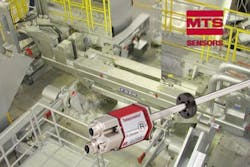Linear Position Sensors in Hot-Dip Galvanizing Applications
The magnetostrictive sensors’ inherent linearity, accuracy, and repeatability made them an ideal fit for any application that requires precision measurement in harsh environments.
"The most important criteria for hot-dip galvanizing with liquid metal is uniform distribution of the coating," said Matt Hankinson, technical marketing manager, MTS Sensors. "High process speed and low material consumption increase the profitability of this process, and Fontaine found that during coating application, our magnetostrictive position sensors played an important role in improving the surface quality of the end product and overall productivity."
Galvanizing equipment manufactured by Fontaine Engineering uses a hot-dip coating method. The strip passes through a molten metal bath, leaving a layer of molten material. After dipping, a 3-roll system guides the strip vertically upwards and corrects any sagging of the material. During this vertical movement, the metal layer is solidified. At high system speeds of up to 240 m/min, there is excess molten metal that remains on the strip. After hot-dip galvanizing, the strips pass through an air knife to accurately adjust the metal coating weight and to smooth the surface, at which point the excess metal returns into the galvanizing bath.
The air knife rigs developed by Fontaine Engineering feature a slit gap in front and behind the strip. Air or nitrogen is forced through the nozzles and directed towards the metal coating, whereby the strip moves upwards in front of the air knife. The controlled air pressure wipes off its excessive material from the strip and achieves a uniform metal coating of 30-300 g/m2 on each side.
The position of the air knives must be maintained with precise alignment to the center line of the running strip during coating. Rather than adjusting the running strip position, the air knives automatically follow the horizontal movements of the strip. Independent of the strip width, the alignment of the center position of the strip to the air knives is controlled with an accuracy of 1 mm.
This precise alignment is ensured through continuous measurement of the strip position during coating. To achieve this, two rod-style linear magnetostrictive position sensors are mounted in the edge coating control system above the air knife and provide feedback to the positioning system. The sensor rods are positioned in parallel to the air knives over their full length. The sensor rods point towards each other and are oriented to the center line of the air knives.
The two sliders of the edge control system are driven towards the strip pneumatically or electrically so that their ceramic rolls touch the edges of the coated strip. Each slider is fitted with a U-shaped position magnet that surrounds the sensor rod without touching it. If the strip moves to the left or to the right during coating, it shifts the sliders with the position magnets. The magnets indicate the position change to the sensors, which measure the deviation of the strip from the center line. Output signals are fed to an electric motor that adjusts the air knives by the measured difference and eliminates the deviation. Thus, the position of air knives is continuously adapted to the movements of the strip. Without this, the air knives would have to be re-adjusted manually again and again.
To ensure uniform coating of the metal strip with minimum tolerances, the MTS sensors in the edge coating control system have a compact, modular design that is easily integrated into the machine design with a maximum size of 105 x 49 x 44 mm. Also, despite difficult environmental conditions, the Temposonics sensors are extremely accurate, with a resolution of 1 micrometer and a linearity deviation of 0.01% of the measuring length to measure even the smallest displacements. Additionally, the sensors are temperature-resistant in a range of -40 °C (-40 °F) to +75 °C (167 °F). With a measuring interval of 0.5 to 3.1 ms (dependent on the measuring length), the sensors can match the scanning cycle of the control system.
Since position measurement does not require direct contact between the position magnet and the sensing element, the operation of Temposonics sensors is free of wear and maintenance. Position measurement is absolute, i.e. no reference run is necessary after machine downtimes.
MTS linear displacement sensors meet all of the requirements for Fontaine Engineering. Even when working with the thinnest metal coatings, the sensors’ precise displacement signals ensure center alignment of the strip to the air knives, resulting in a uniform coating weight.
For more information about Temposonics linear-position sensors and liquid-level measurement, please visit http://www.mtssensors.com.

